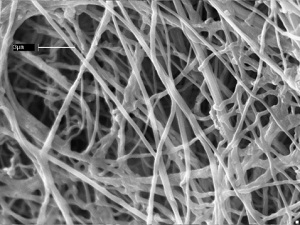Solar-powered jacket: Solar textiles may be weave of the future
 What if we could have tents and car upholstery and clothes woven from solar-powered yarn that had lithium-ion battery storage woven into the backside of it?
What if we could have tents and car upholstery and clothes woven from solar-powered yarn that had lithium-ion battery storage woven into the backside of it?
That’s exactly the technology that Dr. Ray Baughman and his team at the Nanotech Institute at the University of Texas in Dallas have created.
The fibers that Baughman and his team have designed and submitted for patents aren’t just solar energy harvesters and battery storage. The yarns, which can contain various powders and nanofibers used for conducting electric charges, are created using a technique called biscrolling.
The technique incorporates conductive properties into webs of super-strong carbon nanotubes.
“These webs are an unusual state of matter in the sense that they can be lighter than air but still stronger, on a per-weight basis, than steel,” Baughman said.
He said the yarns can be constructed so that one side of them is coated with solar energy harvesting material and the other side with battery powder, turning the inside of the yarn into one big battery electrode.
Baughman and his team have also tested the biscrolled nanotubes to see if they could work as hydrogen fuel cells and other major energy-harvesting and conducting tools with a lot of success, he said.
The technology could also be used to create super-strong synthetic muscles, he said.
“Solar is actually where we’re the least advanced with our demonstrations,” Baughman said.
But there is a lot of interest in the team’s solar research, he said.
“Right now, it costs about $100 a gallon to get into the battlefield in Afghanistan, for example,” Baughman said. “It would be very nice to have an energy-harvesting textile you could roll out and put over your tent.”
The military has been extremely interested in the Nanotech Institute’s research, Baughman said. The Air Force is particularly interested in building a light-weight plane using the institute’s solar-harvesting and battery-storage textiles.
If these textiles take off, they could be used in nearly everything. We could wear solar-energy harvesting coats and have solar-absorbing upholstery in our electric cars of the future.
The technology is not yet ready for the commercial market, Baughman said. But he suspects it will be within the next five years.
“We’ve had a lot of companies approach us who are interested in this,” Baughman said.
Image courtesy of cheme.cornell.edu.



